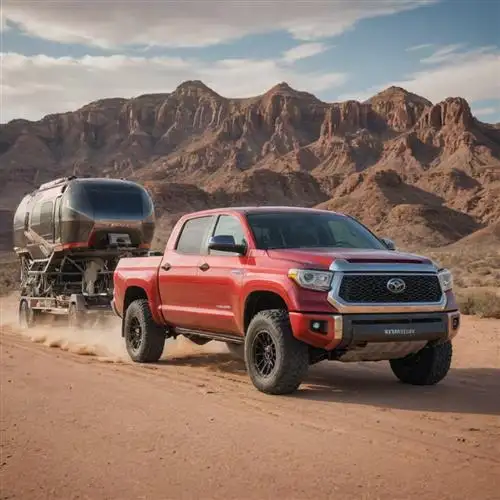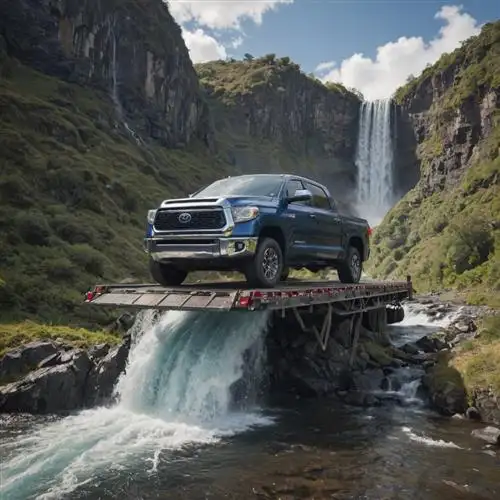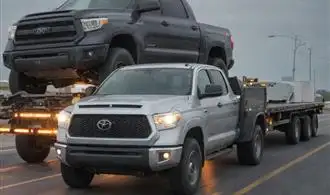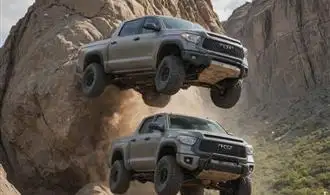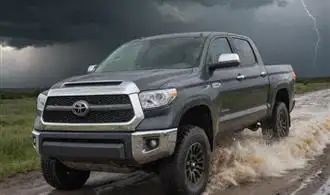
Towing Capacity of the Toyota Tundra
The Toyota Tundra is a versatile full-size pickup truck known for its impressive towing capabilities. When it comes to towing, one of the most important considerations is the vehicle's towing capacity, which refers to the maximum weight the truck can safely pull. The Tundra's towing capacity varies depending on the model, engine, and other factors, but it is generally one of the highest in its class.
The base model Tundra with the standard 4.6-liter V8 engine has a towing capacity of up to 6,800 pounds. However, the real power comes from the optional 5.7-liter V8 engine, which can tow up to 10,200 pounds when properly equipped. This engine, combined with the Tundra's robust frame and suspension, makes it an excellent choice for those who need to haul heavy loads, such as boats, trailers, or large campers.
It's important to note that the Tundra's towing capacity can also be affected by factors such as the weight distribution of the load, the type of trailer being used, and the driving conditions. To ensure safe and efficient towing, it's crucial to follow the manufacturer's recommendations and guidelines, as well as to properly distribute the weight of the load and use the appropriate towing equipment.
In addition to its impressive towing capacity, the Tundra also boasts a range of other features that make it an attractive choice for those who need a reliable and capable towing vehicle. These include:
- Powerful engine options, including the 5.7-liter V8 that delivers up to 381 horsepower and 401 lb-ft of torque
- Available four-wheel-drive system for improved off-road and towing performance
- Advanced towing technology, such as Trailer Sway Control and Trailer Brake Controller, to help ensure safe and stable towing
- Spacious and comfortable interior with ample room for both passengers and cargo
- Rugged and durable construction that can withstand the demands of heavy-duty towing
Hitching and Connecting the Trailer
Properly hitching and connecting the trailer is crucial for safe and secure towing with your Toyota Tundra. The process involves several steps to ensure the trailer is securely attached and balanced. First, you'll need to choose the appropriate hitch receiver for your Tundra model. The Tundra is typically equipped with a 2-inch hitch receiver, but it's important to consult your owner's manual or speak with a Toyota dealer to confirm the correct size.
Once you have the correct hitch receiver, you'll need to attach the trailer's coupler to the hitch. This involves aligning the coupler with the hitch ball, lowering the trailer onto the ball, and securing the latch or lock mechanism. It's essential to ensure the coupler is properly seated on the ball and that the latch or lock is fully engaged. Many trailers also feature a safety chain or cable system, which should be criss-crossed underneath the trailer tongue and attached securely to the Tundra's hitch receiver or frame.
Proper trailer weight distribution is crucial for safe towing. The tongue weight, which is the amount of the trailer's weight that rests on the Tundra's hitch, should be between 10-15% of the trailer's total weight. If the tongue weight is too low, the trailer may become unstable and difficult to control. Conversely, if the tongue weight is too high, it can put excessive strain on the Tundra's rear suspension and make the vehicle difficult to steer. Adjusting the trailer's load or the position of the coupler on the trailer tongue can help achieve the optimal tongue weight.
Finally, it's important to connect the trailer's electrical system to the Tundra. This typically involves plugging the trailer's wiring harness into the vehicle's towing package connector, which provides power for the trailer's brake lights, turn signals, and other electrical components. Ensure all electrical connections are secure and that the trailer's lighting system is fully functional before setting out on the road.
Driving Techniques for Towing with the Tundra
When towing with the Toyota Tundra, it's crucial to master specific driving techniques to ensure safety, stability, and control. The Tundra's impressive towing capacity and robust design make it an excellent choice for hauling heavy loads, but proper technique is essential to navigate the road confidently.
One of the most critical aspects of towing with the Tundra is maintaining a slow, steady speed. Avoid sudden accelerations, braking, or lane changes, as these can cause the trailer to sway and potentially lead to loss of control. Gradually increase or decrease your speed, allowing the trailer to respond smoothly. It's also essential to allow for longer stopping distances, as the added weight of the trailer will require more braking power and time to come to a complete stop.
Another crucial technique is proper weight distribution. Ensure the trailer's weight is balanced correctly, with the majority of the load positioned over the trailer's axles. This will help maintain stability and prevent the trailer from becoming too light or too heavy on the Tundra's rear end, which can lead to sway or fishtailing. Consult your owner's manual or a professional for guidance on proper weight distribution techniques.
When navigating turns and curves, take them wider than you typically would without a trailer. The additional length and weight of the trailer will require more space to maneuver safely. Signal well in advance, and be mindful of the trailer's swing as you turn. Avoid sharp, sudden turns, as this can cause the trailer to jackknife or tip over.
Maintaining proper following distance is also essential when towing with the Tundra. Increase the distance between your vehicle and the one in front of you, allowing for extra time to respond to any sudden changes in traffic or road conditions. This will give you the necessary space to gradually slow down or make evasive maneuvers if needed.
Finally, be aware of the terrain and weather conditions. Steep hills, strong winds, and slippery surfaces can all significantly impact the trailer's stability and your control over the Tundra. Adjust your driving accordingly, using lower gears on hills, reducing speed in high winds, and exercising caution on wet or icy roads.
Balancing Weight and Load Distribution
Towing with the Toyota Tundra requires careful consideration of weight and load distribution to ensure a safe and stable ride. The Tundra's impressive towing capacity can be maximized by understanding the principles of weight balance and how to properly distribute the load.
Firstly, it's crucial to determine the total weight of the trailer and its cargo, and ensure it falls within the Tundra's towing capacity. Exceeding the maximum towing capacity can lead to decreased handling, stability, and braking performance, putting both the driver and other motorists at risk.
Once the total weight is known, the next step is to properly distribute the load. The majority of the trailer's weight should be placed over the axles, with approximately 60% of the weight on the front axle and 40% on the rear. This weight distribution helps maintain the trailer's stability and prevents the rear from swaying or fishtailing.
Additionally, it's essential to consider the tongue weight, which is the downward force exerted on the Tundra's hitch by the trailer. The optimal tongue weight should be around 10-15% of the total trailer weight. This helps maintain the Tundra's stability and prevents the trailer from becoming too light or too heavy on the rear axle.
To ensure proper weight distribution, it's recommended to use a weight-distributing hitch, which utilizes spring bars to distribute the trailer's weight more evenly across the tow vehicle's axles. This setup helps maintain the Tundra's handling and braking capabilities, even when towing a heavy load.
Furthermore, it's important to periodically check the tire pressures on both the Tundra and the trailer to ensure they are within the recommended ranges. Proper tire inflation helps maintain the vehicle's stability and prevents uneven wear or potential blowouts.
Maintaining Safety while Towing with the Tundra
Towing with the Toyota Tundra requires a keen eye for safety. As a full-size pickup, the Tundra offers impressive towing capabilities, but it's crucial to take the necessary precautions to ensure a safe journey. One of the primary considerations is the weight capacity of your Tundra. Meticulously calculate the combined weight of your cargo, trailer, and any passengers to ensure you don't exceed the Tundra's maximum towing capacity. Overloading can compromise the vehicle's handling, braking, and stability, putting you and others on the road at risk.
Proper trailer hitching is paramount. Ensure the hitch is securely connected, and the trailer is level. Use safety chains or cables to provide an additional layer of security in case the primary connection fails. When merging or changing lanes, allow for extra space and time to account for the increased length and weight of your setup. Be mindful of your blind spots and use your side mirrors extensively to maintain awareness of your surroundings.
Braking is a critical aspect of towing safety. The Tundra's powerful braking system is designed to handle the additional weight, but you'll need to increase your following distance and apply the brakes earlier and more gradually than usual. This will help you maintain control and avoid sudden stops that could cause the trailer to sway or jackknife.
Navigating steep inclines and declines also requires special attention. Engage the Tundra's low gear when climbing hills to maintain control and prevent the transmission from overheating. When descending, use engine braking to supplement the vehicle's brakes, reducing the risk of brake fade or failure.
Regularly inspect your tires, including the Tundra's and the trailer's, to ensure proper inflation and tread depth. Underinflated or worn tires can compromise handling and increase the likelihood of a blowout, which can be especially dangerous when towing. Keep an eye on your mirrors and adjust your driving style to account for the increased wind resistance and susceptibility to crosswinds when towing.



